Alfa Romeo MiTo 2013 Owner handbook (in English)
Manufacturer: ALFA ROMEO, Model Year: 2013, Model line: MiTo, Model: Alfa Romeo MiTo 2013Pages: 312, PDF Size: 11.5 MB
Page 101 of 312
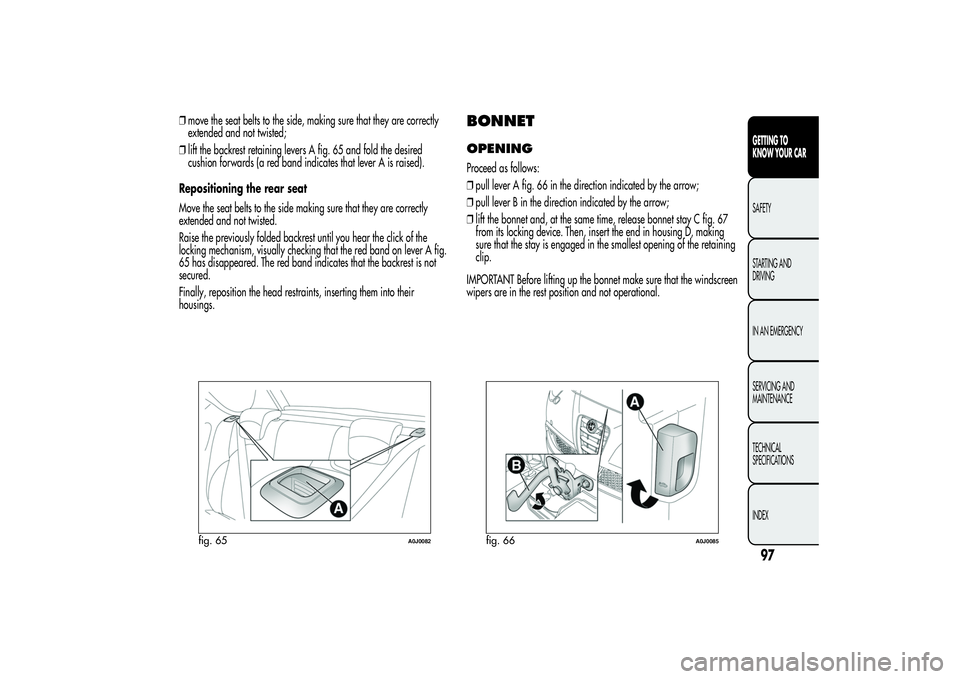
❒move the seat belts to the side, making sure that they are correctly
extended and not twisted;
❒lift the backrest retaining levers A fig. 65 and fold the desired
cushion forwards (a red band indicates that lever A is raised).
Repositioning the rear seat
Move the seat belts to the side making sure that they are correctly
extended and not twisted.
Raise the previously folded backrest until you hear the click of the
locking mechanism, visually checking that the red band on lever A fig.
65 has disappeared. The red band indicates that the backrest is not
secured.
Finally, reposition the head restraints, inserting them into their
housings.
BONNETOPENINGProceed as follows:
❒pull lever A fig. 66 in the direction indicated by the arrow;
❒pull lever B in the direction indicated by the arrow;
❒lift the bonnet and, at the same time, release bonnet stay C fig. 67
from its locking device. Then, insert the end in housing D, making
sure that the stay is engaged in the smallest opening of the retaining
clip.
IMPORTANT Before lifting up the bonnet make sure that the windscreen
wipers are in the rest position and not operational.
fig. 65
A0J0082
fig. 66
A0J0085
97GETTING TO
KNOW YOUR CARSAFETY
STARTING AND
DRIVING
IN AN EMERGENCY
SERVICING AND
MAINTENANCE
TECHNICAL
SPECIFICATIONS
INDEX
Page 102 of 312
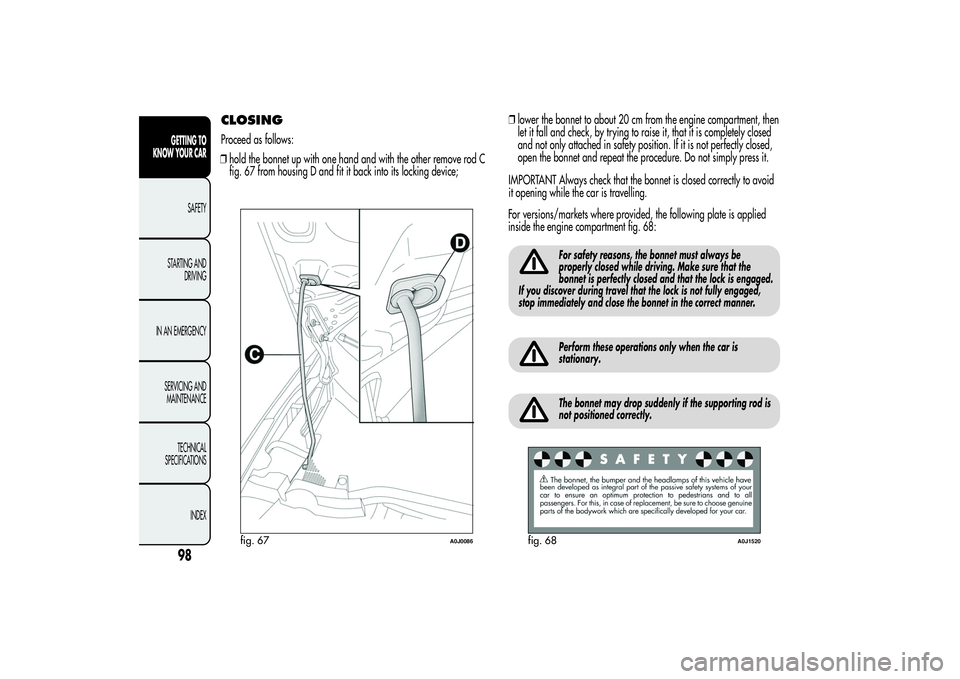
CLOSINGProceed as follows:
❒hold the bonnet up with one hand and with the other remove rod C
fig. 67 from housing D and fit it back into its locking device;❒lower the bonnet to about 20 cm from the engine compartment, then
let it fall and check, by trying to raise it, that it is completely closed
and not only attached in safety position. If it is not perfectly closed,
open the bonnet and repeat the procedure. Do not simply press it.
IMPORTANT Always check that the bonnet is closed correctly to avoid
it opening while the car is travelling.
For safety reasons, the bonnet must always be
properly closed while driving. Make sure that the
bonnet is perfectly closed and that the lock is engaged.
If you discover during travel that the lock is not fully engaged,
stop immediately and close the bonnet in the correct manner.Perform these operations only when the car is
stationary.The bonnet may drop suddenly if the supporting rod is
not positioned correctly.
fig. 67
A0J0086
fig. 68
A0J1520
98GETTING TO
KNOW YOUR CAR
SAFETY
STARTING AND
DRIVING
IN AN EMERGENCY
SERVICING AND
MAINTENANCE
TECHNICAL
SPECIFICATIONS
INDEX
For versions/markets where provided, the following plate is applied
inside the engine compartment fig. 68:
Page 103 of 312
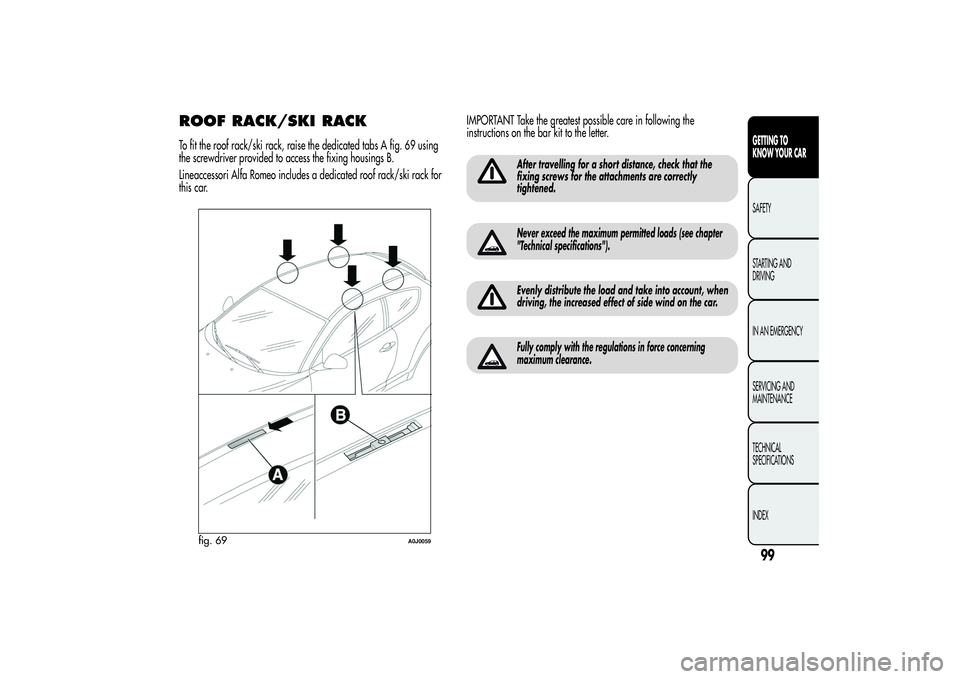
ROOF RACK/SKI RACKTo fit the roof rack/ski rack, raise the dedicated tabs A fig. 69 using
the screwdriver provided to access the fixing housings B.
Lineaccessori Alfa Romeo includes a dedicated roof rack/ski rack for
this car.IMPORTANT Take the greatest possible care in following the
instructions on the bar kit to the letter.
After travelling for a short distance, check that the
fixing screws for the attachments are correctly
tightened.Never exceed the maximum permitted loads (see chapter
"Technical specifications").Evenly distribute the load and take into account, when
driving, the increased effect of side wind on the car.Fully comply with the regulations in force concerning
maximum clearance.
fig. 69
A0J0059
99GETTING TO
KNOW YOUR CARSAFETY
STARTING AND
DRIVING
IN AN EMERGENCY
SERVICING AND
MAINTENANCE
TECHNICAL
SPECIFICATIONS
INDEX
Page 104 of 312
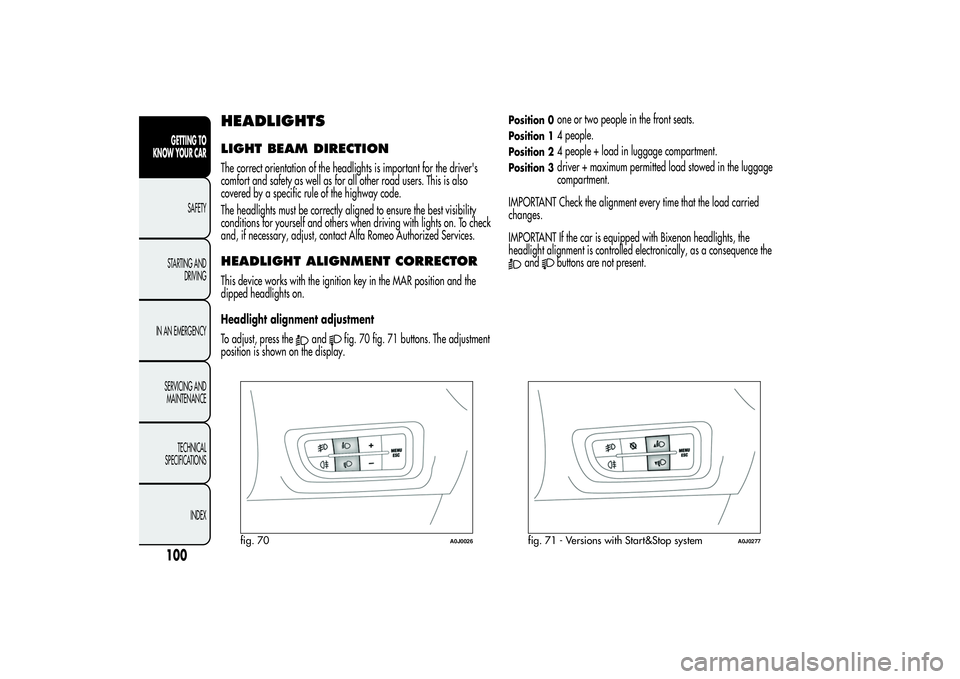
HEADLIGHTSLIGHT BEAM DIRECTIONThe correct orientation of the headlights is important for the driver's
comfort and safety as well as for all other road users. This is also
covered by a specific rule of the highway code.
The headlights must be correctly aligned to ensure the best visibility
conditions for yourself and others when driving with lights on. To check
and, if necessary, adjust, contact Alfa Romeo Authorized Services.HEADLIGHT ALIGNMENT CORRECTORThis device works with the ignition key in the MAR position and the
dipped headlights on.
Headlight alignment adjustment
To adjust, press the
and
fig. 70 fig. 71 buttons. The adjustment
position is shown on the display.
Position 0
one or two people in the front seats.
Position 1
4 people.
Position 2
4 people + load in luggage compartment.
Position 3
driver + maximum permitted load stowed in the luggage
compartment.
IMPORTANT Check the alignment every time that the load carried
changes.
IMPORTANT If the car is equipped with Bixenon headlights, the
headlight alignment is controlled electronically, as a consequence the
and
buttons are not present.
fig. 70
A0J0026
fig. 71 - Versions with Start&Stop system
A0J0277
100GETTING TO
KNOW YOUR CAR
SAFETY
STARTING AND
DRIVING
IN AN EMERGENCY
SERVICING AND
MAINTENANCE
TECHNICAL
SPECIFICATIONS
INDEX
Page 105 of 312
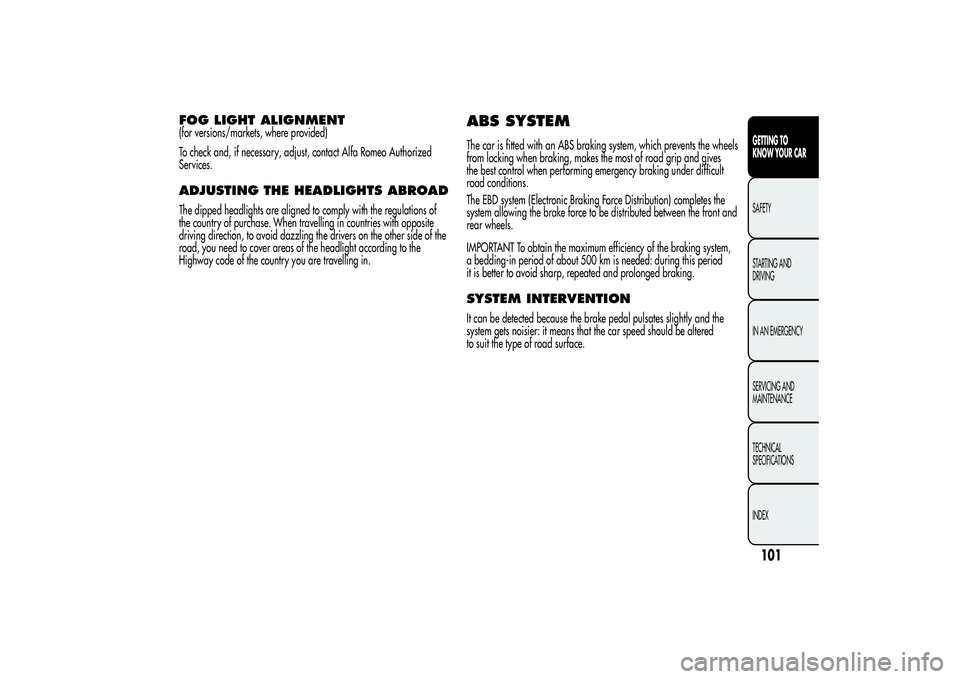
FOG LIGHT ALIGNMENT(for versions/markets, where provided)
To check and, if necessary, adjust, contact Alfa Romeo Authorized
Services.ADJUSTING THE HEADLIGHTS ABROADThe dipped headlights are aligned to comply with the regulations of
the country of purchase. When travelling in countries with opposite
driving direction, to avoid dazzling the drivers on the other side of the
road, you need to cover areas of the headlight according to the
Highway code of the country you are travelling in.
ABS SYSTEMThe car is fitted with an ABS braking system, which prevents the wheels
from locking when braking, makes the most of road grip and gives
the best control when performing emergency braking under difficult
road conditions.
The EBD system (Electronic Braking Force Distribution) completes the
system allowing the brake force to be distributed between the front and
rear wheels.
IMPORTANT To obtain the maximum efficiency of the braking system,
a bedding-in period of about 500 km is needed: during this period
it is better to avoid sharp, repeated and prolonged braking.SYSTEM INTERVENTIONIt can be detected because the brake pedal pulsates slightly and the
system gets noisier: it means that the car speed should be altered
to suit the type of road surface.
101GETTING TO
KNOW YOUR CARSAFETY
STARTING AND
DRIVING
IN AN EMERGENCY
SERVICING AND
MAINTENANCE
TECHNICAL
SPECIFICATIONS
INDEX
Page 106 of 312
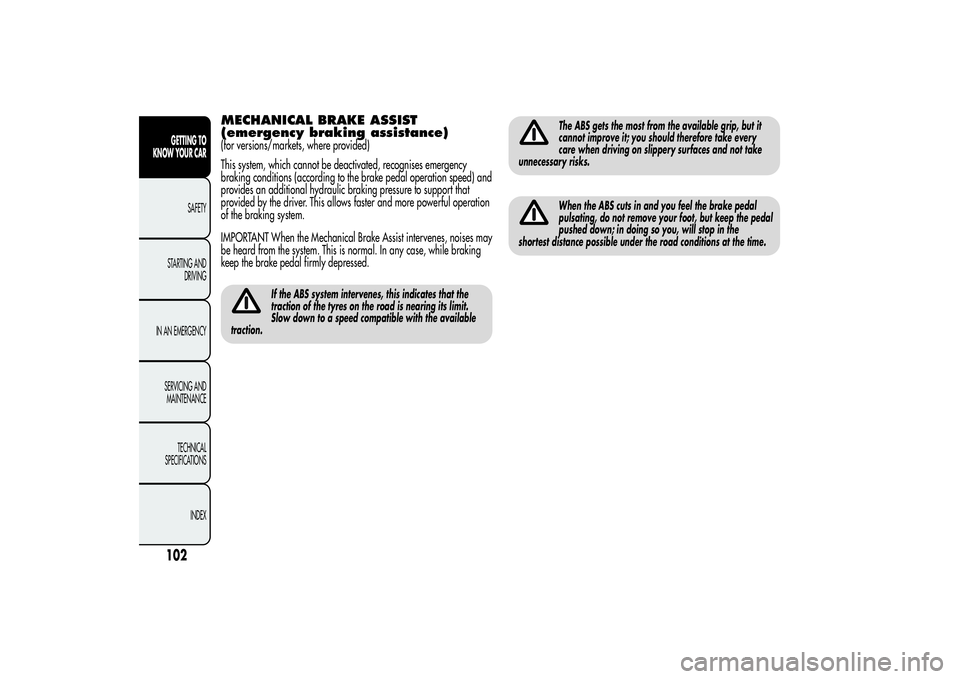
MECHANICAL BRAKE ASSIST
(emergency braking assistance)(for versions/markets, where provided)
This system, which cannot be deactivated, recognises emergency
braking conditions (according to the brake pedal operation speed) and
provides an additional hydraulic braking pressure to support that
provided by the driver. This allows faster and more powerful operation
of the braking system.
IMPORTANT When the Mechanical Brake Assist intervenes, noises may
be heard from the system. This is normal. In any case, while braking
keep the brake pedal firmly depressed.
If the ABS system intervenes, this indicates that the
traction of the tyres on the road is nearing its limit.
Slow down to a speed compatible with the available
traction.
The ABS gets the most from the available grip, but it
cannot improve it; you should therefore take every
care when driving on slippery surfaces and not take
unnecessary risks.When the ABS cuts in and you feel the brake pedal
pulsating, do not remove your foot, but keep the pedal
pushed down; in doing so you, will stop in the
shortest distance possible under the road conditions at the time.
102GETTING TO
KNOW YOUR CAR
SAFETY
STARTING AND
DRIVING
IN AN EMERGENCY
SERVICING AND
MAINTENANCE
TECHNICAL
SPECIFICATIONS
INDEX
Page 107 of 312
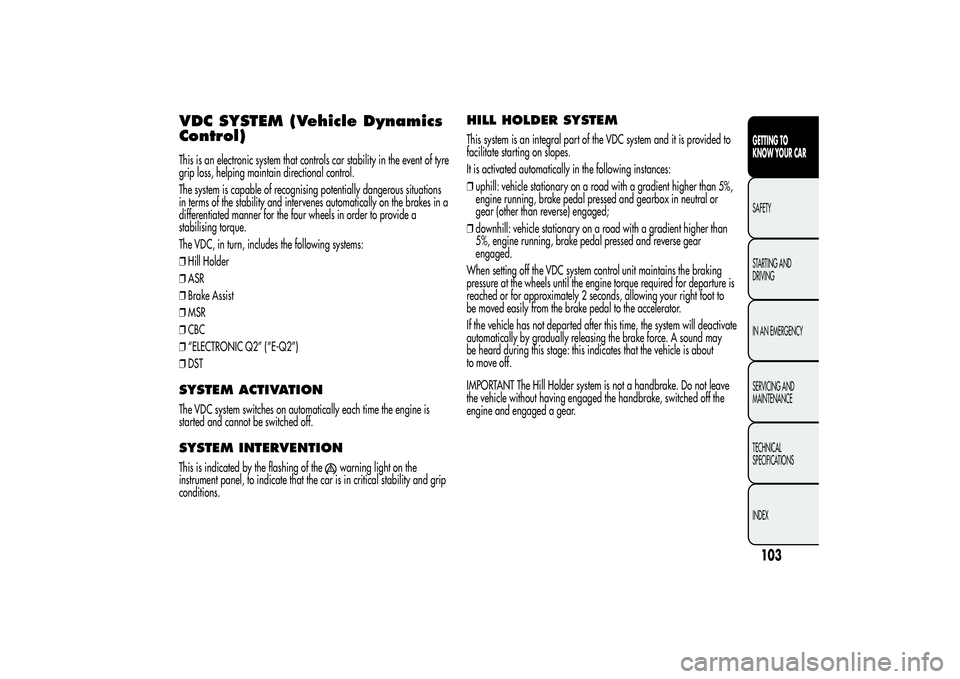
VDC SYSTEM (Vehicle Dynamics
Control)This is an electronic system that controls car stability in the event of tyre
grip loss, helping maintain directional control.
The system is capable of recognising potentially dangerous situations
in terms of the stability and intervenes automatically on the brakes in a
differentiated manner for the four wheels in order to provide a
stabilising torque.
The VDC, in turn, includes the following systems:
❒Hill Holder
❒ASR
❒Brake Assist
❒MSR
❒CBC
❒“ELECTRONIC Q2” (“E-Q2”)
❒DSTSYSTEM ACTIVATIONThe VDC system switches on automatically each time the engine is
started and cannot be switched off.SYSTEM INTERVENTIONThis is indicated by the flashing of the
warning light on the
instrument panel, to indicate that the car is in critical stability and grip
conditions.
HILL HOLDER SYSTEMThis system is an integral part of the VDC system and it is provided to
facilitate starting on slopes.
It is activated automatically in the following instances:
❒uphill: vehicle stationary on a road with a gradient higher than 5%,
engine running, brake pedal pressed and gearbox in neutral or
gear (other than reverse) engaged;
❒downhill: vehicle stationary on a road with a gradient higher than
5%, engine running, brake pedal pressed and reverse gear
engaged.
When setting off the VDC system control unit maintains the braking
pressure at the wheels until the engine torque required for departure is
reached or for approximately 2 seconds, allowing your right foot to
be moved easily from the brake pedal to the accelerator.
If the vehicle has not departed after this time, the system will deactivate
automatically by gradually releasing the brake force. A sound may
be heard during this stage: this indicates that the vehicle is about
to move off.
IMPORTANT The Hill Holder system is not a handbrake. Do not leave
the vehicle without having engaged the handbrake, switched off the
engine and engaged a gear.
103GETTING TO
KNOW YOUR CARSAFETY
STARTING AND
DRIVING
IN AN EMERGENCY
SERVICING AND
MAINTENANCE
TECHNICAL
SPECIFICATIONS
INDEX
Page 108 of 312
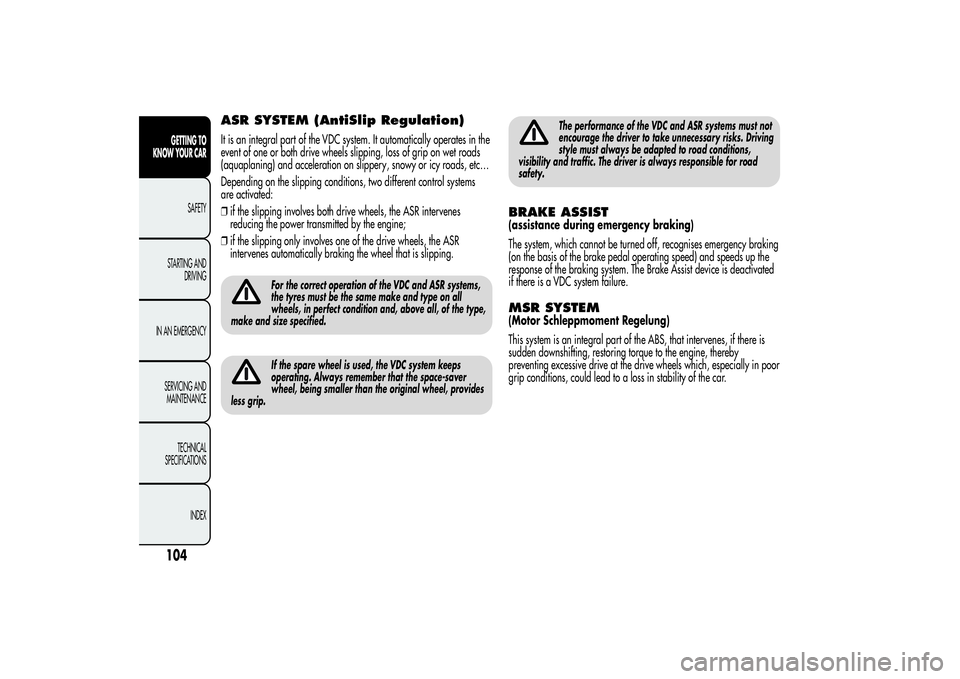
ASR SYSTEM (AntiSlip Regulation)It is an integral part of the VDC system. It automatically operates in the
event of one or both drive wheels slipping, loss of grip on wet roads
(aquaplaning) and acceleration on slippery, snowy or icy roads, etc…
Depending on the slipping conditions, two different control systems
are activated:
❒if the slipping involves both drive wheels, the ASR intervenes
reducing the power transmitted by the engine;
❒if the slipping only involves one of the drive wheels, the ASR
intervenes automatically braking the wheel that is slipping.
For the correct operation of the VDC and ASR systems,
the tyres must be the same make and type on all
wheels, in perfect condition and, above all, of the type,
make and size specified.If the spare wheel is used, the VDC system keeps
operating. Always remember that the space-saver
wheel, being smaller than the original wheel, provides
less grip.
The performance of the VDC and ASR systems must not
encourage the driver to take unnecessary risks. Driving
style must always be adapted to road conditions,
visibility and traffic. The driver is always responsible for road
safety.
BRAKE ASSIST(assistance during emergency braking)
The system, which cannot be turned off, recognises emergency braking
(on the basis of the brake pedal operating speed) and speeds up the
response of the braking system. The Brake Assist device is deactivated
if there is a VDC system failure.MSR SYSTEM(Motor Schleppmoment Regelung)
This system is an integral part of the ABS, that intervenes, if there is
sudden downshifting, restoring torque to the engine, thereby
preventing excessive drive at the drive wheels which, especially in poor
grip conditions, could lead to a loss in stability of the car.
104GETTING TO
KNOW YOUR CAR
SAFETY
STARTING AND
DRIVING
IN AN EMERGENCY
SERVICING AND
MAINTENANCE
TECHNICAL
SPECIFICATIONS
INDEX
Page 109 of 312
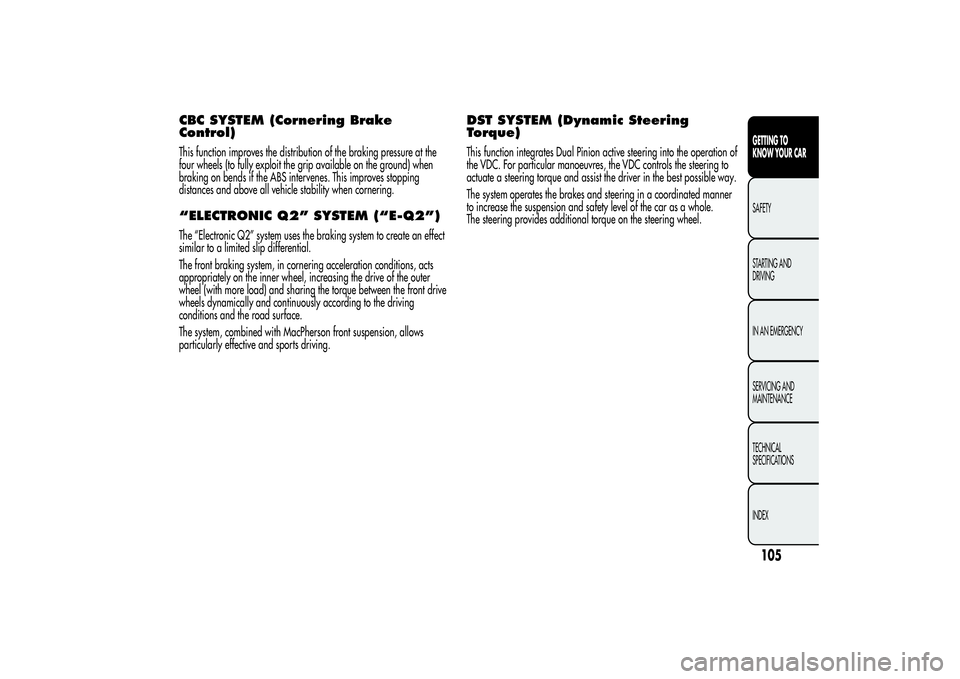
CBC SYSTEM (Cornering Brake
Control)This function improves the distribution of the braking pressure at the
four wheels (to fully exploit the grip available on the ground) when
braking on bends if the ABS intervenes. This improves stopping
distances and above all vehicle stability when cornering.“ELECTRONIC Q2” SYSTEM (“E-Q2”)The “Electronic Q2” system uses the braking system to create an effect
similar to a limited slip differential.
The front braking system, in cornering acceleration conditions, acts
appropriately on the inner wheel, increasing the drive of the outer
wheel (with more load) and sharing the torque between the front drive
wheels dynamically and continuously according to the driving
conditions and the road surface.
The system, combined with MacPherson front suspension, allows
particularly effective and sports driving.
DST SYSTEM (Dynamic Steering
Torque)This function integrates Dual Pinion active steering into the operation of
the VDC. For particular manoeuvres, the VDC controls the steering to
actuate a steering torque and assist the driver in the best possible way.
The system operates the brakes and steering in a coordinated manner
to increase the suspension and safety level of the car as a whole.
The steering provides additional torque on the steering wheel.
105GETTING TO
KNOW YOUR CARSAFETY
STARTING AND
DRIVING
IN AN EMERGENCY
SERVICING AND
MAINTENANCE
TECHNICAL
SPECIFICATIONS
INDEX
Page 110 of 312
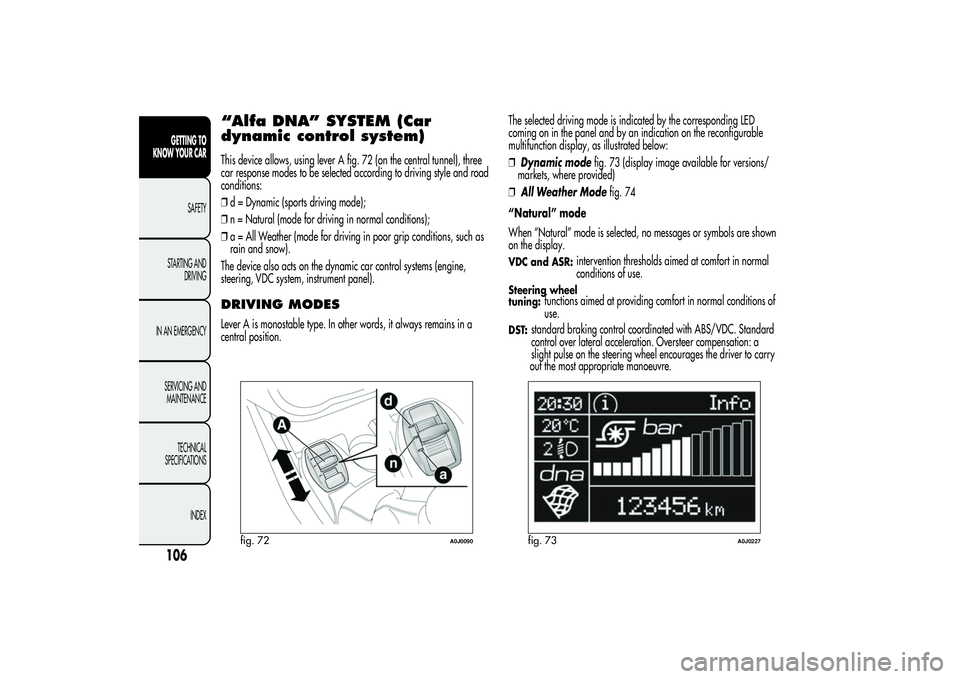
“Alfa DNA” SYSTEM (Car
dynamic control system)This device allows, using lever A fig. 72 (on the central tunnel), three
car response modes to be selected according to driving style and road
conditions:
❒d = Dynamic (sports driving mode);
❒n = Natural (mode for driving in normal conditions);
❒a = All Weather (mode for driving in poor grip conditions, such as
rain and snow).
The device also acts on the dynamic car control systems (engine,
steering, VDC system, instrument panel).DRIVING MODESLever A is monostable type. In other words, it always remains in a
central position.The selected driving mode is indicated by the corresponding LED
coming on in the panel and by an indication on the reconfigurable
multifunction display, as illustrated below:
❒Dynamic modefig. 73 (display image available for versions/
markets, where provided)
❒All Weather Modefig. 74
“Natural” mode
When “Natural” mode is selected, no messages or symbols are shown
on the display.
VDC and ASR:
intervention thresholds aimed at comfort in normal
conditions of use.
Steering wheel
tuning:
functions aimed at providing comfort in normal conditions of
use.
DST:
standard braking control coordinated with ABS/VDC. Standard
control over lateral acceleration. Oversteer compensation: a
slight pulse on the steering wheel encourages the driver to carry
fig. 72
A0J0090
fig. 73
A0J0227
106GETTING TO
KNOW YOUR CAR
SAFETY
STARTING AND
DRIVING
IN AN EMERGENCY
SERVICING AND
MAINTENANCE
TECHNICAL
SPECIFICATIONS
INDEX
out the most appropriate manoeuvre.